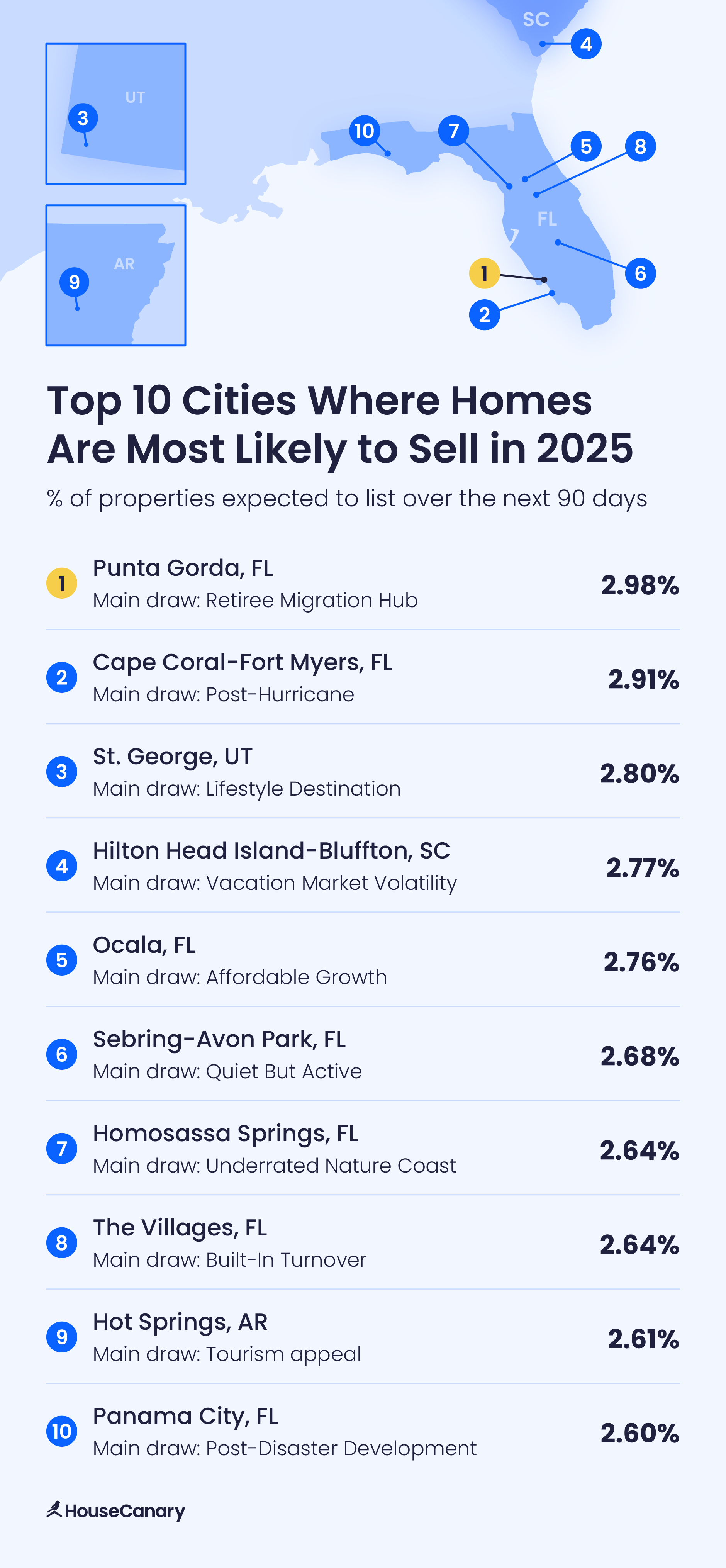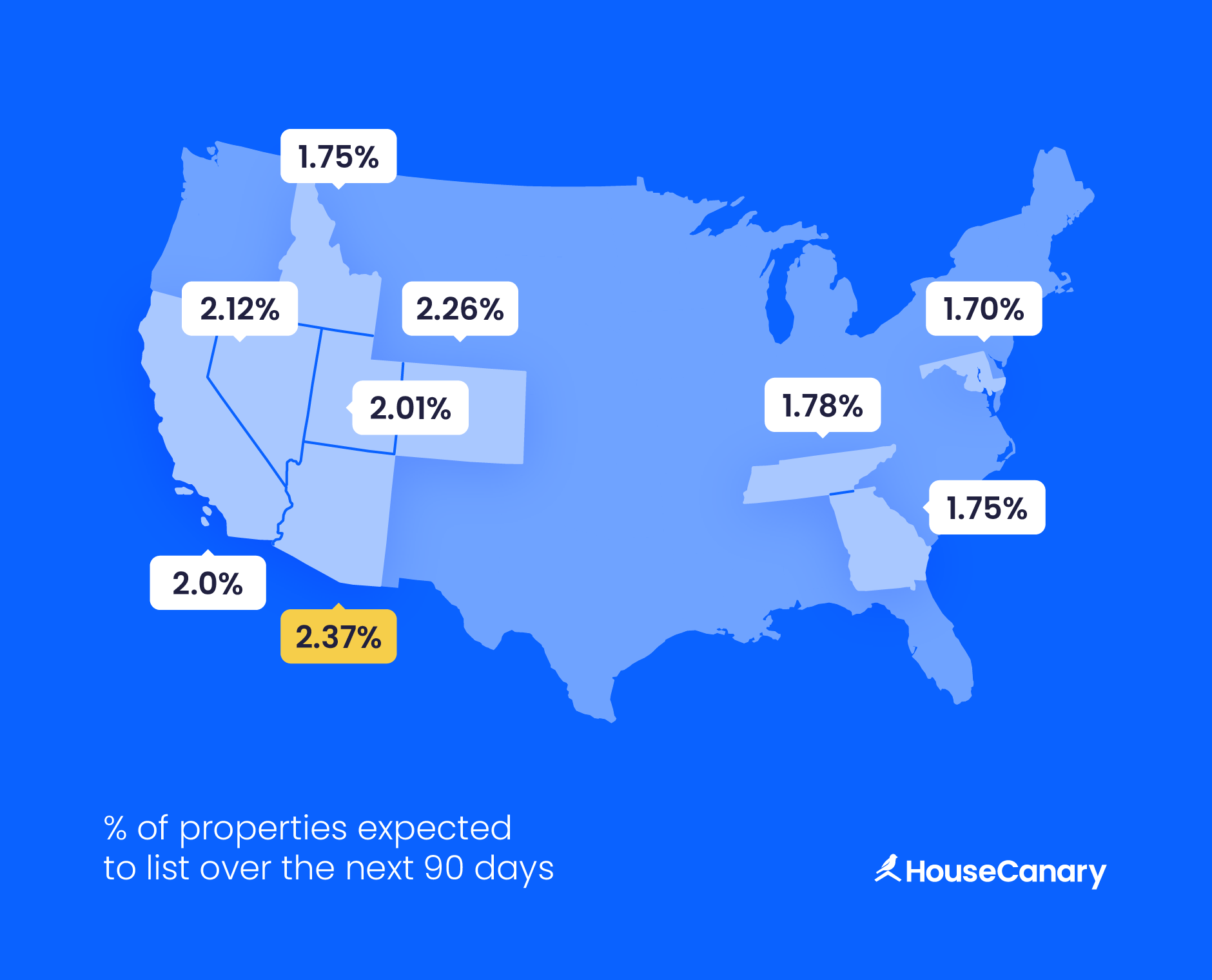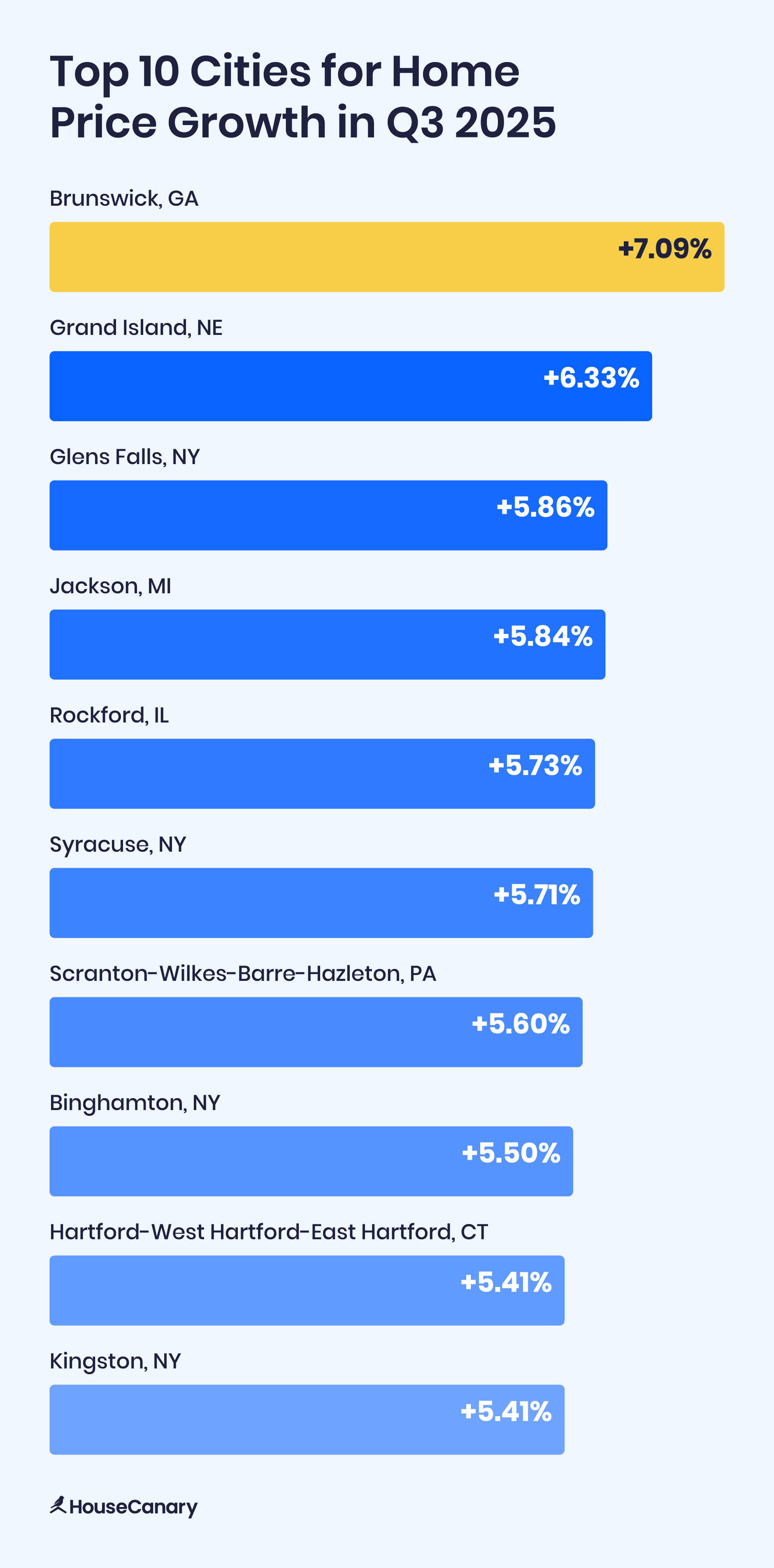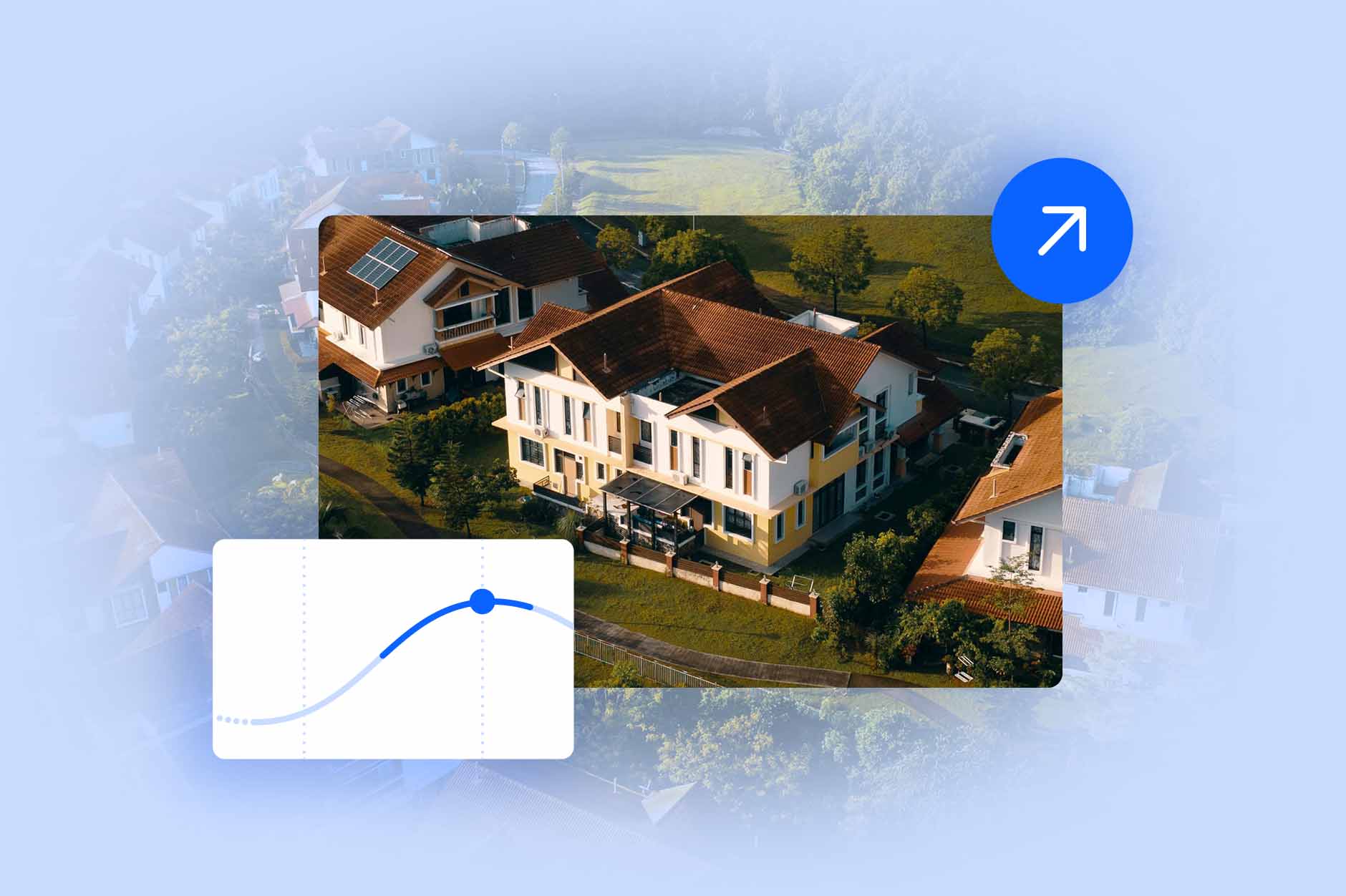.jpeg)
While the housing market is notoriously unpredictable, advanced market data can make it easier to stay ahead in the real estate sector.
Arkansas stands out for its steady momentum: Prices are projected to climb another 8% by mid-2028, signaling resilience in smaller markets often overlooked in national forecasts. That kind of steady growth, even amid broader national shifts, highlights the value of analyzing regional trends to identify opportunities.
This report explores the top 10 metros for home sales through Q4 2025, emerging regional real estate market trends, forecasted price growth, and the best markets for long-term investment.
Whether you’re an investor looking to target high-yield metros or a real estate agent planning your next move, using predictive tools like HouseCanary's programmatic data gives you an edge in navigating the ever-changing market.
Housing Market Predictions Overview
Housing market uncertainty remains top of mind as we close out 2025, but data-driven forecasts help buyers, sellers, and investors stay ahead. By analyzing trends like migration, inflation, and climate risk, you can anticipate shifts and price listings accurately.
Buyers are continuing to move from high-cost coastal cities like San Francisco and New York to more affordable mid-sized cities, particularly in the Florida market. Generally, these areas have lower taxes, a warmer climate, and growing job markets that offer better value and quality of life.
Key insights:
- Inventory Increasing: While still low from a historical perspective, levels are now the highest since COVID in early 2020. Rising inventory, combined with low sales volume, is shifting conditions toward a buyer’s market.
- Price growth is slowing: Nationwide home price growth is decelerating. Price growth is flat in most markets, but is unlikely to turn negative.
- Regional variation is widening: Some cities may see modest price corrections, while others are poised for strong growth. For example, Brunswick, GA (+7.1% YoY), Grand Island, NE (+6.3%), and Glens Falls, NY (+5.9%) are exhibiting robust price growth.
- Investor interest is rising: Rental properties are becoming more attractive as investors seek stable returns amid stock market volatility. Smaller metros like Hot Springs, AR, and St. George, UT, are seeing consistent listing activity, making them appealing for long-term rental investments.
Will the Housing Market Crash Near the End of 2025?
Despite ongoing concerns, a full-scale housing market crash by the end of 2025 is highly unlikely. While some markets may experience modest price corrections, national indicators— low inventory levels and relatively strong employment—point to a more stable outlook.
Inventory remains limited compared to historical norms, and demand continues to be supported by demographic shifts, including millennial homebuyers and migration to affordable metros.
Top 10 Cities Where Homes Are Most Likely to Sell in Q2 2025
In Q3 2025, the U.S. housing market exhibited signs of cooling, characterized by a slight year-over-year decrease in median home prices and an increase in inventory levels.
Specifically, Florida experienced a 0.55% decline in median closed prices, with a median of 74 days on market. This dip indicates a shift towards a more buyer-friendly environment.
This trend was also observed nationally: Many small and midsize cities experiencing price appreciation, while larger metros like Florida and Texas saw flat or slightly negative growth.
Looking ahead to Q4 2025, HouseCanary's data suggests that similar metro areas are poised for continued activity. To provide additional context on the current market dynamics, Chris Stroud, HouseCanary’s Chief of Research, explains:
“Most markets are trending at multiyear lows in terms of overall listing activity; both in terms of new listings as well as the number of listings going into contract. Mountain West states and Florida are expected to have robust listing activity through the end of the year. However, the elevated listing activity in these regions is also leading to elevated inventory, putting increasing pressure on price growth.”
—Chris Stroud, Chief of Research
Each city on this list has a distinct driver behind its projected listing volume, from seasonal turnover in retiree communities to post-recovery activity in hurricane-impacted markets. Let’s dive into the metros most likely to see turnover in Q4 and explore how to find the best real estate markets to invest in using data-driven strategies.

1. Punta Gorda, FL
With a projected listing rate of 2.98%, Punta Gorda leads the nation in expected home listings relative to its housing stock. This Southwest Florida city continues to attract retirees and remote workers, and its high turnover rate suggests a dynamic market.
The elevated listing activity likely reflects ongoing migration trends, increased seller confidence, and continued reshuffling among seasonal and second-home owners.
2. Cape Coral-Fort Myers, FL
Cape Coral-Fort Myers ranks second with a 2.91% expected listing rate, indicating frequent market churn. As one of the fastest-growing regions in Florida, this area remains a hot spot for both investment and relocation.
Despite recent hurricane-related disruptions, the market is rebounding quickly, and high seller participation suggests renewed confidence.
3. St. George, UT
St. George is the only city outside the Southeast in the top five, with a projected listing rate of 2.80%.
The region's popularity among retirees—and its ongoing population growth—continues to drive housing demand and seller activity. Its scenic appeal and status as a lifestyle destination keep the market active even amid broader economic uncertainty.
4. Hilton Head Island-Bluffton, SC
Hilton Head’s listing rate of 2.77% signals strong turnover in a market known for second homes and luxury vacation properties. As demand for resort-like living remains high, many homeowners are taking advantage of favorable selling conditions. Generational shifts and estate sales may also drive inventory growth in this area.
5. Ocala, FL
Ocala’s expected listing rate of 2.76% reflects its emergence as a more affordable alternative within Florida’s interior. The area’s growing population, driven by both retirees and workforce housing demand, has created an environment ripe for listings. Sellers are responding to increased buyer interest by bringing more properties to market.
6. Sebring-Avon Park, FL
With a listing rate of 2.68%, Sebring-Avon Park is seeing increased turnover in its quiet, retiree-oriented market. Its low cost of living and attractive climate continue to appeal to downsizers and seasonal residents, resulting in steady listing activity relative to its size.
7. Homosassa Springs, FL
Homosassa Springs projects a 2.64% listing rate, driven by its affordability and natural amenities. As a quieter part of Florida’s Nature Coast, it’s benefiting from increased attention from buyers priced out of larger metros, prompting more homeowners to list their properties while demand remains strong.
8. The Villages, FL
The Villages shows a projected 2.64% listing rate, reflecting high natural turnover in this retirement community. As one of the fastest-growing metro areas for older adults, The Villages has a constant inflow and outflow of residents, resulting in a consistently high volume of property listings.
9. Hot Springs, AR
Hot Springs is projected to see a 2.61% listing rate, placing it among the nation’s most active housing markets. Its combination of affordability, tourism appeal, and steady population growth makes Hot Springs an attractive market for both sellers and investors looking for opportunity.
10. Panama City, FL
Panama City has a 2.60% listing rate, boosted by continued recovery and development following recent hurricanes. The coastal market is popular among both vacation-home seekers and investors, and the rising listing rate reflects increased seller engagement as the area stabilizes.
State-Level Housing Trends
While metro-level activity reveals where homes are most likely to sell, state-level housing market forecasts offer a broader view of market momentum. Several states stand out in listing activity, driven by migration, affordability, and favorable economic conditions.
HouseCanary’s proprietary data reveals that the Florida housing market tops the list of states with the highest expected listing activity in Q4 2025, with 2.42% of homes projected to hit the market over the next 90 days. This positions it as a major hot spot for real estate professionals, though rising inventory may also affect price growth.
Other high-activity states include:
- Arizona (2.37%): Fueled by steady migration and relatively affordable desert metros
- Colorado (2.26%): Especially active in suburban and mountain-adjacent regions
- Nevada (2.12%): Las Vegas drives activity, but inventory is climbing fast
- Utah (2.01%): Secondary metros like St. George push the state into the top five
- California (2.0%): Still high in absolute numbers, but movement is slower than in other states
- Tennessee (1.78%): Steady listing rates in fast-growing cities like Nashville and Knoxville
- Idaho (1.75%): Post-pandemic rebalancing in markets like Boise keeps turnover strong
- Georgia (1.75%): Atlanta suburbs remain a draw for price-sensitive buyers
- Maryland (1.70%): Suburban D.C. areas are seeing consistent sales

Housing Price Forecasts for Q4 2025 and Beyond
HouseCanary's latest home sale price forecast data reveals that many small and midsize U.S. cities will see price appreciation through the third quarter of 2025. These projections, based on the HouseCanary Home Price Index (HPI), reflect key market indicators like inventory levels, listing activity, and buyer demand.
Understanding where and why prices will likely rise helps investors and agents make smarter decisions about where to buy, sell, or hold, especially in a market where regional performance varies widely.
"From a national persepctive, we can expect a moderate increase in prices of +3% y-o-y. Price growth will vary by region, with the strongest growth expected in the Midwest and New England. The weakest growth will be in parts of the South, including Florida and Texas. Some MSAs in this region are expected to see moderate decreases in home prices y-o-y.”
—Chris Stroud, Chief of Research
Key forecasts include:
- Brunswick, GA leads all metros with a projected +7.1% year-over-year home price growth, signaling strong upward pressure on prices in this market.
- Grand Island, NE, and Glens Falls, NY, follow with expected increases of +6.3% and +5.9%.
- Midwestern cities like Jackson, MI (+5.8%) and Rockford, IL (+5.7%) are also seeing stronger-than-average price momentum.
- Syracuse, NY, and Hartford, CT, are forecast to see +5% appreciation, suggesting a shift in demand toward lower-cost, historically stable housing markets

How Mortgage Rates Affect Housing Market Predictions
Mortgage rates significantly influence housing market dynamics, impacting both buyer affordability and seller behavior. The Federal Reserve cut its benchmark federal funds rate by 0.25% in September 2025, slightly easing borrowing costs.
Even with this reduction, mortgage rates remain elevated compared to the historic lows experienced a few years ago, meaning monthly payments are still relatively high and could temper demand in some markets. Conversely, lower rates typically encourage more buyers to enter the market, boosting sales velocity and supporting price growth.
For loan officers, leveraging tools like HouseCanary's Automated Valuation Model (AVM) and Portfolio Monitoring can enhance underwriting accuracy and client engagement. These tools provide real-time property valuations, enabling quicker pre-qualification processes and more informed lending decisions.
By staying informed on mortgage rate trends and utilizing advanced analytics, loan officers can better anticipate market shifts and advise clients effectively.
The Best Cities for Long-Term Investment
Determining the best cities for long-term investment relies on listing rate growth and home price appreciation forecasts. Using proprietary HouseCanary data, we’ve identified the top five U.S. markets offering strong potential return on investment (ROI) through the end of 2025 and into 2026.
1. Jacksonville, NC
- Listing rate growth (3-month): 2.43%
- 12-month price appreciation forecast: 4.60%
A fast-growing military and coastal community, Jacksonville stands out with strong housing demand, a healthy balance of new inventory, and appreciating home values.
2. Grand Junction, CO
- Listing rate growth (3-month): 2.12%
- 12-month price appreciation forecast: 4.33%
Grand Junction benefits from limited housing supply and growing interest from remote workers and retirees, supporting listing activity and price growth.
3. Reno, NV
- Listing rate growth (3-month): 2.21%
- 12-month price appreciation forecast: 4.28%
With a diversifying economy and spillover from California markets, Reno offers solid fundamentals for long-term investment, combining sustained listing growth with strong price performance.
4. Fort Collins, CO
- Listing rate growth (3-month): 2.23%
- 12-month price appreciation forecast: 4.28%
This college town continues to attract families and professionals seeking quality of life and stable job markets, driving steady listing increases and price growth.
5. Orlando-Kissimmee-Sanford, FL
- Listing rate growth (3-month): 2.25%
- 12-month price appreciation forecast: 4.26%
Orlando’s strong tourism, health care, and education sectors keep housing demand elevated, while its surrounding suburbs are seeing increasing inventory without significant downward pressure on home values.
These markets represent a combination of expanding inventory and healthy price appreciation, making them top picks for real estate investors focused on long-term growth.
The Importance of Predictive Analytics in Real Estate
As the housing market continues to shift near the end of 2025, predictive analytics will play an increasingly important role in shaping strategy for investors, agents, and lenders.
Accurate housing market predictions allow stakeholders to make data-informed decisions, avoid risk, and identify opportunities before they become obvious. Combining real-time insights with historical trends, modern real estate AI tools can reveal where the market is and where it’s headed.
Looking to get ahead of market trends before they happen? HouseCanary’s Instant Insights delivers real-time data on any property or market nationwide, helping professionals act faster with confidence. For a deeper dive, Property Explorer lets you search, analyze, and compare markets at a more detailed level. Start making smarter real estate decisions today with predictive analytics.























